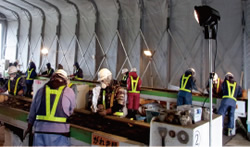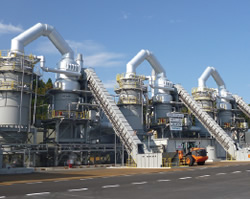 Relations with Society
Relations with Society
The DOWA group would like to make various contributions by tackling with social issues through our business activities. We also would like to create values sought by all of our stakeholders by continuing growth through our business activities in harmony with society.
Continuous Support for Reconstruction from the Great East Japan Earthquake
The DOWA group has been extending support for reconstruction from the Great East Japan Earthquake of March 11, 2011. We are now shifting the support from initial emergency support focusing on monetary donations and goods to reconstruction support that meet the local needs through our business activities. Two years have already passed since the earthquake. We believe that action with maintained interest in the disaster is important. We aim at extending support activities from the medium- and long-term standpoint.
Organization of a the Earthquake Reconstruction Support Team
In May 2011, DOWA ECO-SYSTEM organized an earthquake reconstruction support team and opened its office for the team in Sendai City. We cooperated with Fukushima Prefecture for its decontamination work that started in 2012, in addition to our industrial waste disposal support, capitalizing on our technologies and know-how of waste disposal, recycling, soil remediation, environmentally-friendly logistics and plant engineering.
Smooth Disposal of Waste and Refuse due to Disaster
We supported the disposal of waste and refuse generated due to the Earthquake in Iwate Prefecture and Miyagi Prefecture. Our main activities were coordination of wide area disposal and logistics, segregation of wreckage for local disposal and incineration.
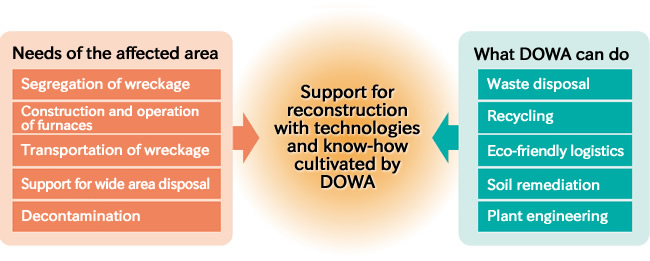
< Wide area disposal >
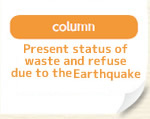
One of the challenges in reconstruction from the Great East Japan Earthquake is disposal of waste and refuse due to the Earthquake and the deposits due to the tsunami. Japanese Government estimated that the amount of waste and refuse due to the Earthquake is approximately 4.76 million tons in Iwate Prefecture (approximately equal to eleven years of domestic waste generated) and approximately 15.69 million tons (nineteen years worth of waste) in Miyagi Prefecture. As their disposal is the major part of the recovery and reconstruction from the Earthquake, 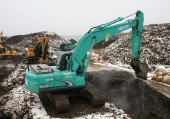 local governments took leadership of the disposal, based on the basic policy of the Ministry of the Environment. The waste and refuse must be properly segregated into those that can be recycled, those to be incinerated and those to be buried and properly disposed of.
local governments took leadership of the disposal, based on the basic policy of the Ministry of the Environment. The waste and refuse must be properly segregated into those that can be recycled, those to be incinerated and those to be buried and properly disposed of.
< Local disposal >

Other Activities in 2012
The Mobile Library Project for the Affected Areas
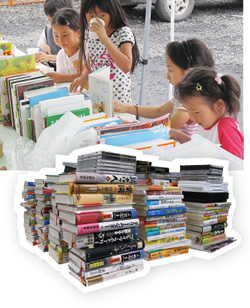
Employees of the DOWA group brought in used books and CDs for three months from February to May 2012 and sold them as part of support for reconstruction of the Great East Japan Earthquake. The DOWA group donated the money to the Shanti Volunteer Association that operates mobile libraries in the affected areas. These mobile libraries deliver books to the temporary houses in Miyagi Prefecture and Fukushima Prefecture in addition to the drastically affected area along the coast of Iwate Prefecture. In May 2012, we donated our original eco-bags so that people could put their borrowed books in the bag when they visited mobile libraries.
Our employees considered seriously how they could participate in the support activities for the affected people with their own initiatives. This project was the product of their efforts and the headquarters started this project in 2011, informing our business establishments of the project in the newsletters of the DOWA group. We gathered used books and CDs again in December 2012.Tohoku Rainbow House Project
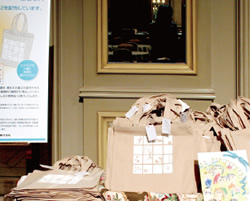
We handed out a copy of CSR report in a reusable eco-bag at the general meeting of shareholders. We donated half of the eco-bag production cost to support for starting up the Tohoku Rainbow House for ASHINAGA, the Educational and Emotional Support for Orphans Worldwide that will support for daily care activities of the affected children in 2012.
We started handing out eco-bags to our shareholders at the general meeting six years ago, as people could use eco-bags longer than paper bags, aimed at conserving environment and resources. We chose to purchase eco-bags through fair trade sources and insulated cooler bags for promoting energy saving activities. We produce bags, considering the theme of the bag every year as a tool to support our CSR efforts.

